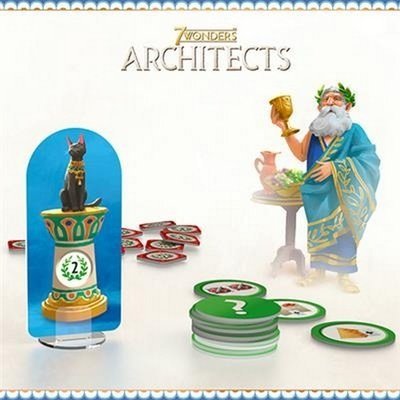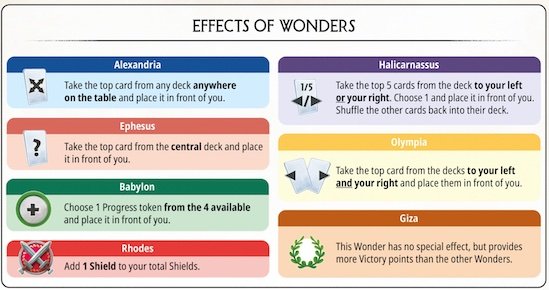7 Wonders Architects Review by Aurore
7 Wonders Architects is a simple game with surprising depth and competitive potential. At first glance it seems incredibly random, but upon reaching a certain level of understanding the depth of your decisions become apparent.
Aurore’s Score: 8/10
Decision Space
On face value the decision space is very narrow. In each turn you typically only get to choose which card to take from one of three decks of cards. Not only that, but because one deck is hidden and two decks are revealed, it is generally better to take from the random deck, because taking from a revealed deck has a chance of giving your opponent more information.
Different cards, wonders, and information can all change the decision space over the course of the game. This makes the decision space dynamic. Some high value cards might have you choosing from a side deck right off the bat, but otherwise the first few turns usually involve players simply taking a random card.
What is interesting is that the value of the same card can also change throughout the game. A shield is worth a lot if your opponents have none, but becomes completely worthless if it is late in the game and your opponents have much more than you. To explore the decision space of 7 wonders, I’d like to go over some of the elements in the game and see how they affect the decision space.
Blue Cards
There are two blue cards in the game, one grants 3 points and the other grants 2 points and control over the cat. The 3 points card is a very strong card. If you look at the average points value of resource cards it is quite a bit lower and can even be as low as 1 point for some wonders. An action worth 3 points can be a great boon, increasing your average points per turn. Whether to take them depends on your strategy, stage of the game, and your ability to build an engine.
I can say that a 3 point card is a tempo loss. You’re giving up an opportunity to close out the game faster, build an engine, or take something else that could provide ongoing value.
The cat is below average points for a turn, but the information it grants is invaluable. Knowing which card is available in the middle of the deck allows you to pass on it to take something more valuable from a side deck. It can also allow you to avoid taking cards you don’t want. A shield with horns when you’re losing is bad, so is a resource you can’t use. Even a 3 point card can be a detriment when you’re trying to close out the game fast before your opponents build an engine.
Lastly, the cat allows you to “trap” opponents, leaving a card the next opponent cannot use, or even harm them. If you take a card from a side deck that appears to be valuable for you, they may fall for it and it feels great when they do. You can also use this information to stop a player from ending the game, giving you more time to build an engine and score points, and maybe even finish your wonder first.
Technology
I won’t go over all the technologies as there are many of them, but the most important ones are the ones that grant additional cards when you trigger them. Cards that trigger off getting cards can vastly increase the number of cards you get throughout the game, but also allow you to take a card from a side deck and get first pick at the next card behind it. Those technologies change the value of cards and encourage you to grab cards from side decks.
But maybe even more interesting is considering when to deny an opponent with a technology an opportunity to grab a card that triggers an additional card draw. In two player games, and often in three player games, denying is important, but the more players there are in the game the higher the cost to you, so you may decide to let them have it.
The technology that grants an additional card when building a stage in your wonder can be deceptively powerful for wonders that have stages that allow grabbing additional cards. Especially ones that take those cards from side piles, as it mitigates the problem of giving your opponent a first pick opportunity at a powerful card.
Shields
I already lightly touched on the subject, but wars in 7 wonders architects are an interesting problem. If there are a lot of horns in the game, then having shields without horns can be a massive advantage. But sometimes the horns just don’t show up and you’re left investing in shields that provide little to no value. Generally speaking, if you get 3 points per card you’re doing well, but ideally you could get far more.
There is also the potential of creating situations where if your opponent draws a shield with horns from the center deck they get nothing and lose a card. Likewise, your opponent may put you in that situation, which makes choosing cards from the side decks appealing, as the risk is minimized.
Resources
We’ve already gone over the benefits when you have technologies, but there are other situations to consider. Being able to close out the second to last stage requiring 3 of the same type can be very important, otherwise you sometimes get useless cards trying to complete it. Every resource that is unspent at the end of the game is wasted, so making sure you can use them is essential to winning.
Wonders
The staccato way that wonder stages are built is the tempo of the game. Closing out the game when your opponent has 6 unused resources is brutal. But closing the game is not the only way to win, if you focus on 3 point cards, war, and technology points, you can win games without finishing your wonder. The key is having a minimum number of wasted cards at the end of the game.
Different wonders have different potential strategies. Some wonders grant additional cards and are the best for rushing the end of the game, while others provide the tools to build strong technology engines that can churn out points if the game goes long. Paying attention to your opponents, their wonders, and the strategy they are following can also change the decision space. If your opponent is rushing, you might choose not to build an engine, but focus on high point sources like war, blue cards, and points from technology cards.
Summary
7 Wonders Architects has a high luck factor that makes it a wonderful game to play with kids and family, but it is not a mindless game. A discerning player will have ample opportunities to improve their play.
This article was written by Aurore of Timeshapers.com. Join the Decision Space discord to discuss the article and let me know if you’d like to see more Decision Space in written form.




